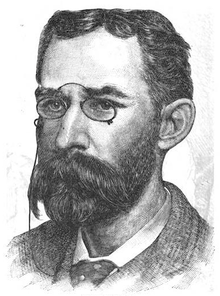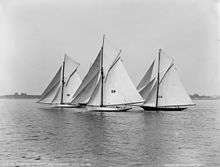Edward Burgess (yacht designer)


Edward Burgess (1848–1891) was an American yacht designer, born June 30, 1848 in West Sandwich, Massachusetts.
Edward is fifth son of Benjamin Franklin Burgess (1818–1909) and Cordelia Williams Ellis(1821–1876). The Burgess family were merchants who made their money in the West Indies trade and lost it in 1879. They had a summer residence in Beverly, Massachusetts.
Edward was educated at Harvard, graduating in 1871, and became secretary of the Boston Society of Natural History, in which capacity he edited the publications of the society, and published several memoirs on anatomical subjects. In 1879 he became instructor in entomology at Harvard, remaining until 1883. He traveled in Europe, and, in an amateur way, studied the principles of naval architecture, bringing his knowledge and judgment to the practical test of designing and building vessels for his own use. His success in this line was so marked that when, in 1883, a reverse of fortune threw him upon his own resources for a livelihood, he naturally turned to the designing of sailing yachts.
Several of his boats won fame in the waters of the eastern United States, and when, in 1884, it became necessary to build a large sloop yacht to represent the United States in a series of international races, he was selected by a committee of Bostonians to draw plans for a suitable vessel. From his designs the Puritan was built, which easily defeated the Genesta (English) in the races for the America's Cup in 1885. This was a remarkable triumph in view of the fact that it was the first attempt of an American designer to solve certain shipbuilding problems to which Englishmen had given their attention for a score of years.
In 1886, his Mayflower, slightly larger than the Puritan, led in the race with the English Galatea. In 1888 his fishing schooner Carrie E. Phillips distanced four competitors in the fisherman's race held in Boston harbor. His Volunteer won the America's cup against the Thistle, the special product of British genius, in the international races of 1887. His other yachts included the Mariquita and Gossoon, both remarkably swift sloops designed to counter the success of the Clyde-built cutter Minerva (William Fife, 1888).
Edward married Caroline Louisa Sullivant on June 2, 1877 in Boston. She was born 2 November 1852 in Columbus Ohio and is daughter of William Starling & Caroline Eudora (Sutton) Sullivant. They had two sons William Starling Burgess and Charles Paine Burgess. Edward died July 12, 1891 of typhoid fever.[1] Caroline died 16 September 16, 1891 in Boston of pneumonia. They are both buried at Mount Auburn Cemetery lot #1167 Geranium Path.
Burgess was inducted into the America's Cup Hall of Fame in 1994.
Sources
| Wikimedia Commons has media related to Edward Burgess. |
- ↑ "His loss greatly felt". New York Times. 1891-07-19.
- Adolphus Gustavus McVey (1892). "Edward Burgess and his work". New England Magazine. Vol. V. pp. 49–62.
- Boston's North Shore by Joseph E.Garland. Published 1978.
- Benjamin Franklin Burgess Obituary, NEHGS Register Volume 65 xlviii, 1911.
- 139.Benjamin Franklin Burgess genealogy.
- Tasha Tudor ancestry.
 Wilson, James Grant; Fiske, John, eds. (1900). "Burgess, Edward". Appletons' Cyclopædia of American Biography. New York: D. Appleton.
Wilson, James Grant; Fiske, John, eds. (1900). "Burgess, Edward". Appletons' Cyclopædia of American Biography. New York: D. Appleton.
External links
- The location of the early Burgess summer cottage is now Lynch Park in Beverly, Massachusetts. Latter it was owned by the Evans Family who hosted President William Howard Tafts 1910 summer "Whitehouse".
- A map of Beverly Cove from the 1872 Atlas of Essex County plate 95, showing the Burgess cottage off Ober Street on Woodbury Point.
 "Burgess, Edward". Collier's New Encyclopedia. 1921.
"Burgess, Edward". Collier's New Encyclopedia. 1921.
![]() This article incorporates text from a publication now in the public domain: Gilman, D. C.; Thurston, H. T.; Colby, F. M., eds. (1905). "article name needed". New International Encyclopedia (1st ed.). New York: Dodd, Mead.
This article incorporates text from a publication now in the public domain: Gilman, D. C.; Thurston, H. T.; Colby, F. M., eds. (1905). "article name needed". New International Encyclopedia (1st ed.). New York: Dodd, Mead.